Analysis of Harm Minimisation Strategies and Their Impact in Australia
VerifiedAdded on 2023/01/18
|8
|2446
|98
Essay
AI Summary
This essay examines the concept of harm minimisation strategies within the Australian healthcare system, focusing on their impact on drug use and its associated health, social, and economic consequences. The paper discusses the three key pillars of harm minimisation: harm reduction, supply reduction, and demand reduction. Harm reduction strategies aim to lessen the adverse effects of drug use, while supply reduction focuses on controlling the availability of illicit drugs, and demand reduction seeks to decrease the desire for drug use within the community. The essay analyzes the impact of these strategies on various aspects of Australian society, referencing relevant policies, programs, and research to evaluate their effectiveness in mitigating drug-related harm. The conclusion summarizes the strategies, emphasizing the importance of a multifaceted approach to address the complex issue of drug use and its impact on individuals and communities.
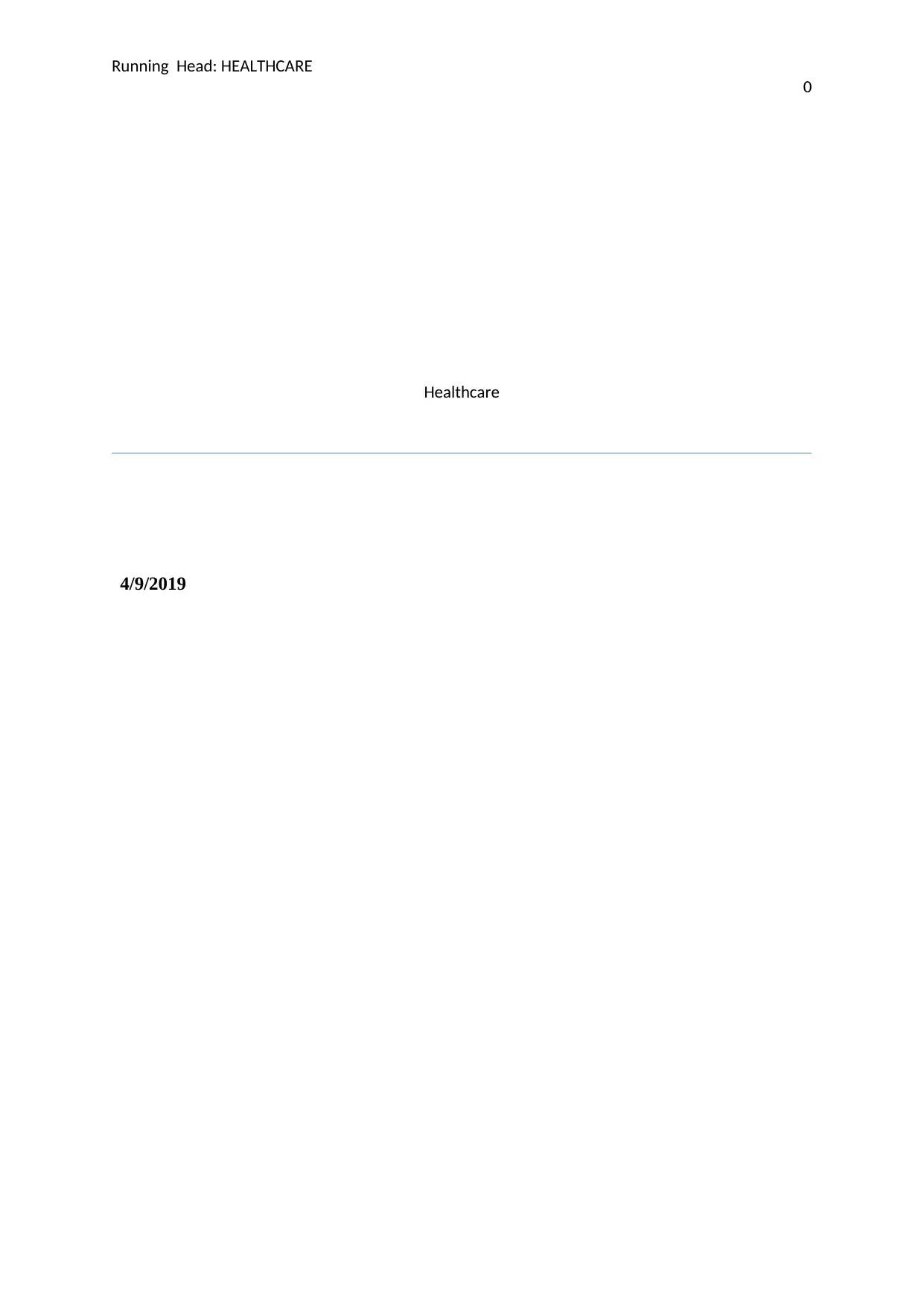
Running Head: HEALTHCARE
0
Healthcare
4/9/2019
0
Healthcare
4/9/2019
Paraphrase This Document
Need a fresh take? Get an instant paraphrase of this document with our AI Paraphraser
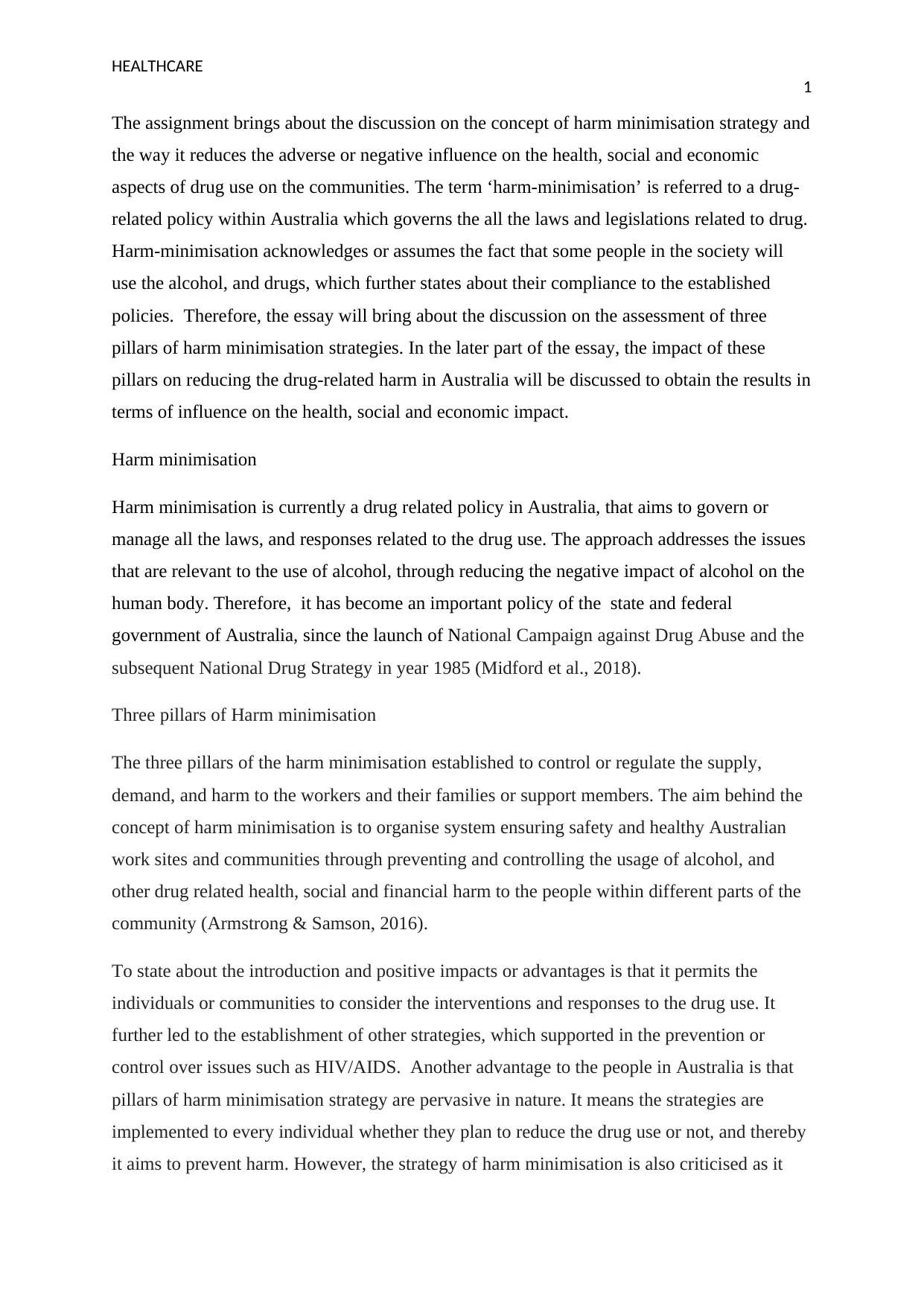
HEALTHCARE
1
The assignment brings about the discussion on the concept of harm minimisation strategy and
the way it reduces the adverse or negative influence on the health, social and economic
aspects of drug use on the communities. The term ‘harm-minimisation’ is referred to a drug-
related policy within Australia which governs the all the laws and legislations related to drug.
Harm-minimisation acknowledges or assumes the fact that some people in the society will
use the alcohol, and drugs, which further states about their compliance to the established
policies. Therefore, the essay will bring about the discussion on the assessment of three
pillars of harm minimisation strategies. In the later part of the essay, the impact of these
pillars on reducing the drug-related harm in Australia will be discussed to obtain the results in
terms of influence on the health, social and economic impact.
Harm minimisation
Harm minimisation is currently a drug related policy in Australia, that aims to govern or
manage all the laws, and responses related to the drug use. The approach addresses the issues
that are relevant to the use of alcohol, through reducing the negative impact of alcohol on the
human body. Therefore, it has become an important policy of the state and federal
government of Australia, since the launch of National Campaign against Drug Abuse and the
subsequent National Drug Strategy in year 1985 (Midford et al., 2018).
Three pillars of Harm minimisation
The three pillars of the harm minimisation established to control or regulate the supply,
demand, and harm to the workers and their families or support members. The aim behind the
concept of harm minimisation is to organise system ensuring safety and healthy Australian
work sites and communities through preventing and controlling the usage of alcohol, and
other drug related health, social and financial harm to the people within different parts of the
community (Armstrong & Samson, 2016).
To state about the introduction and positive impacts or advantages is that it permits the
individuals or communities to consider the interventions and responses to the drug use. It
further led to the establishment of other strategies, which supported in the prevention or
control over issues such as HIV/AIDS. Another advantage to the people in Australia is that
pillars of harm minimisation strategy are pervasive in nature. It means the strategies are
implemented to every individual whether they plan to reduce the drug use or not, and thereby
it aims to prevent harm. However, the strategy of harm minimisation is also criticised as it
1
The assignment brings about the discussion on the concept of harm minimisation strategy and
the way it reduces the adverse or negative influence on the health, social and economic
aspects of drug use on the communities. The term ‘harm-minimisation’ is referred to a drug-
related policy within Australia which governs the all the laws and legislations related to drug.
Harm-minimisation acknowledges or assumes the fact that some people in the society will
use the alcohol, and drugs, which further states about their compliance to the established
policies. Therefore, the essay will bring about the discussion on the assessment of three
pillars of harm minimisation strategies. In the later part of the essay, the impact of these
pillars on reducing the drug-related harm in Australia will be discussed to obtain the results in
terms of influence on the health, social and economic impact.
Harm minimisation
Harm minimisation is currently a drug related policy in Australia, that aims to govern or
manage all the laws, and responses related to the drug use. The approach addresses the issues
that are relevant to the use of alcohol, through reducing the negative impact of alcohol on the
human body. Therefore, it has become an important policy of the state and federal
government of Australia, since the launch of National Campaign against Drug Abuse and the
subsequent National Drug Strategy in year 1985 (Midford et al., 2018).
Three pillars of Harm minimisation
The three pillars of the harm minimisation established to control or regulate the supply,
demand, and harm to the workers and their families or support members. The aim behind the
concept of harm minimisation is to organise system ensuring safety and healthy Australian
work sites and communities through preventing and controlling the usage of alcohol, and
other drug related health, social and financial harm to the people within different parts of the
community (Armstrong & Samson, 2016).
To state about the introduction and positive impacts or advantages is that it permits the
individuals or communities to consider the interventions and responses to the drug use. It
further led to the establishment of other strategies, which supported in the prevention or
control over issues such as HIV/AIDS. Another advantage to the people in Australia is that
pillars of harm minimisation strategy are pervasive in nature. It means the strategies are
implemented to every individual whether they plan to reduce the drug use or not, and thereby
it aims to prevent harm. However, the strategy of harm minimisation is also criticised as it
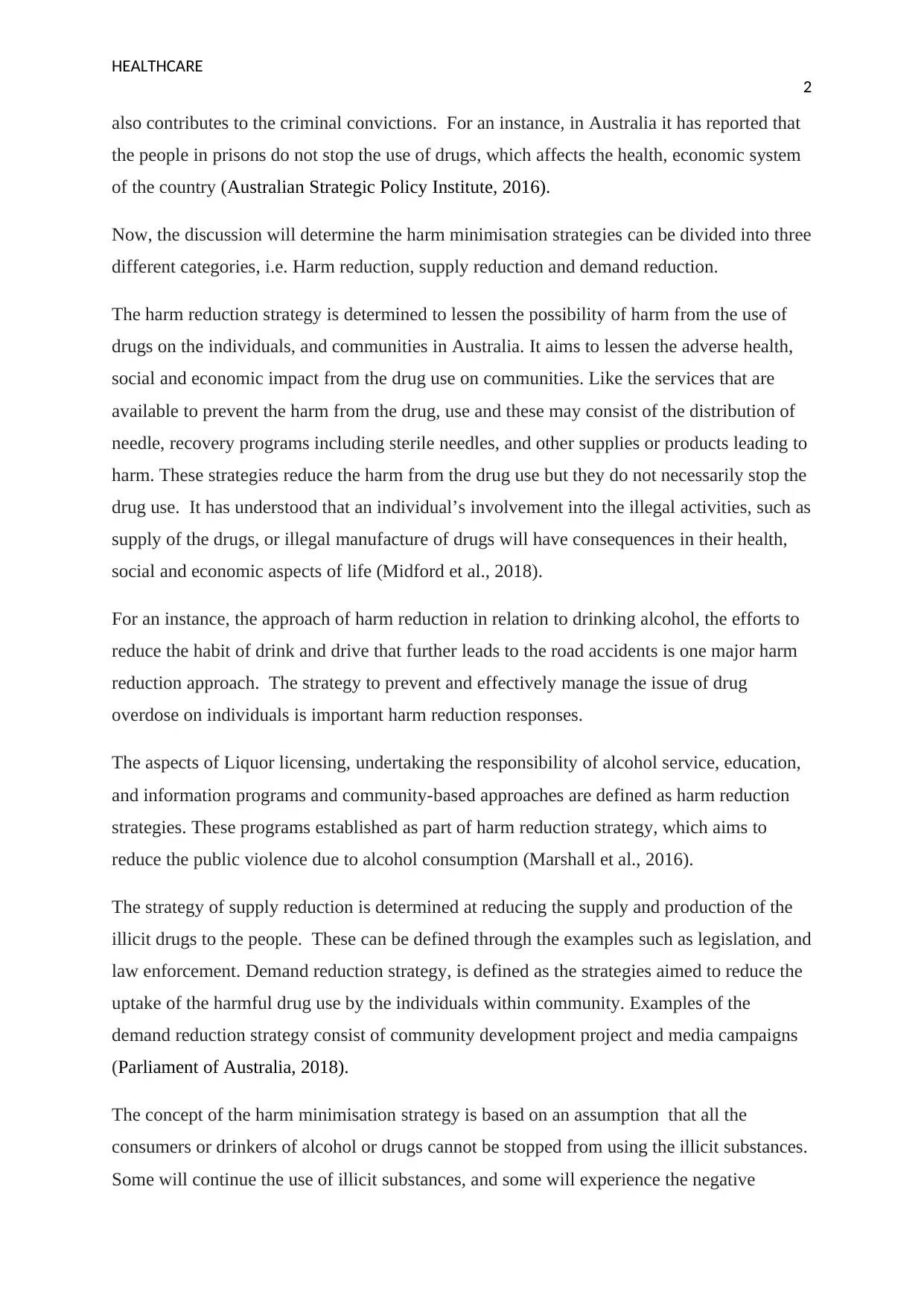
HEALTHCARE
2
also contributes to the criminal convictions. For an instance, in Australia it has reported that
the people in prisons do not stop the use of drugs, which affects the health, economic system
of the country (Australian Strategic Policy Institute, 2016).
Now, the discussion will determine the harm minimisation strategies can be divided into three
different categories, i.e. Harm reduction, supply reduction and demand reduction.
The harm reduction strategy is determined to lessen the possibility of harm from the use of
drugs on the individuals, and communities in Australia. It aims to lessen the adverse health,
social and economic impact from the drug use on communities. Like the services that are
available to prevent the harm from the drug, use and these may consist of the distribution of
needle, recovery programs including sterile needles, and other supplies or products leading to
harm. These strategies reduce the harm from the drug use but they do not necessarily stop the
drug use. It has understood that an individual’s involvement into the illegal activities, such as
supply of the drugs, or illegal manufacture of drugs will have consequences in their health,
social and economic aspects of life (Midford et al., 2018).
For an instance, the approach of harm reduction in relation to drinking alcohol, the efforts to
reduce the habit of drink and drive that further leads to the road accidents is one major harm
reduction approach. The strategy to prevent and effectively manage the issue of drug
overdose on individuals is important harm reduction responses.
The aspects of Liquor licensing, undertaking the responsibility of alcohol service, education,
and information programs and community-based approaches are defined as harm reduction
strategies. These programs established as part of harm reduction strategy, which aims to
reduce the public violence due to alcohol consumption (Marshall et al., 2016).
The strategy of supply reduction is determined at reducing the supply and production of the
illicit drugs to the people. These can be defined through the examples such as legislation, and
law enforcement. Demand reduction strategy, is defined as the strategies aimed to reduce the
uptake of the harmful drug use by the individuals within community. Examples of the
demand reduction strategy consist of community development project and media campaigns
(Parliament of Australia, 2018).
The concept of the harm minimisation strategy is based on an assumption that all the
consumers or drinkers of alcohol or drugs cannot be stopped from using the illicit substances.
Some will continue the use of illicit substances, and some will experience the negative
2
also contributes to the criminal convictions. For an instance, in Australia it has reported that
the people in prisons do not stop the use of drugs, which affects the health, economic system
of the country (Australian Strategic Policy Institute, 2016).
Now, the discussion will determine the harm minimisation strategies can be divided into three
different categories, i.e. Harm reduction, supply reduction and demand reduction.
The harm reduction strategy is determined to lessen the possibility of harm from the use of
drugs on the individuals, and communities in Australia. It aims to lessen the adverse health,
social and economic impact from the drug use on communities. Like the services that are
available to prevent the harm from the drug, use and these may consist of the distribution of
needle, recovery programs including sterile needles, and other supplies or products leading to
harm. These strategies reduce the harm from the drug use but they do not necessarily stop the
drug use. It has understood that an individual’s involvement into the illegal activities, such as
supply of the drugs, or illegal manufacture of drugs will have consequences in their health,
social and economic aspects of life (Midford et al., 2018).
For an instance, the approach of harm reduction in relation to drinking alcohol, the efforts to
reduce the habit of drink and drive that further leads to the road accidents is one major harm
reduction approach. The strategy to prevent and effectively manage the issue of drug
overdose on individuals is important harm reduction responses.
The aspects of Liquor licensing, undertaking the responsibility of alcohol service, education,
and information programs and community-based approaches are defined as harm reduction
strategies. These programs established as part of harm reduction strategy, which aims to
reduce the public violence due to alcohol consumption (Marshall et al., 2016).
The strategy of supply reduction is determined at reducing the supply and production of the
illicit drugs to the people. These can be defined through the examples such as legislation, and
law enforcement. Demand reduction strategy, is defined as the strategies aimed to reduce the
uptake of the harmful drug use by the individuals within community. Examples of the
demand reduction strategy consist of community development project and media campaigns
(Parliament of Australia, 2018).
The concept of the harm minimisation strategy is based on an assumption that all the
consumers or drinkers of alcohol or drugs cannot be stopped from using the illicit substances.
Some will continue the use of illicit substances, and some will experience the negative
⊘ This is a preview!⊘
Do you want full access?
Subscribe today to unlock all pages.

Trusted by 1+ million students worldwide
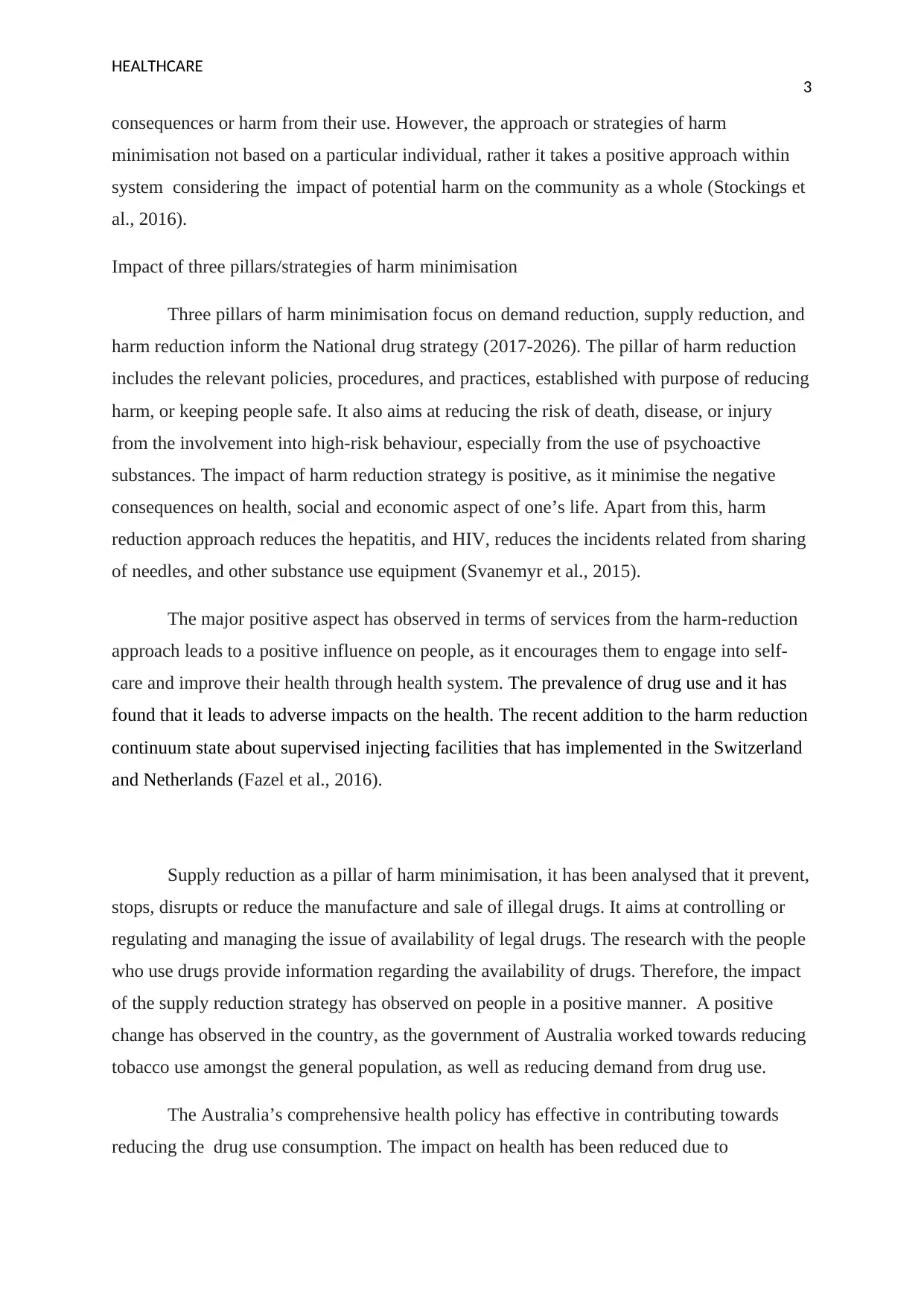
HEALTHCARE
3
consequences or harm from their use. However, the approach or strategies of harm
minimisation not based on a particular individual, rather it takes a positive approach within
system considering the impact of potential harm on the community as a whole (Stockings et
al., 2016).
Impact of three pillars/strategies of harm minimisation
Three pillars of harm minimisation focus on demand reduction, supply reduction, and
harm reduction inform the National drug strategy (2017-2026). The pillar of harm reduction
includes the relevant policies, procedures, and practices, established with purpose of reducing
harm, or keeping people safe. It also aims at reducing the risk of death, disease, or injury
from the involvement into high-risk behaviour, especially from the use of psychoactive
substances. The impact of harm reduction strategy is positive, as it minimise the negative
consequences on health, social and economic aspect of one’s life. Apart from this, harm
reduction approach reduces the hepatitis, and HIV, reduces the incidents related from sharing
of needles, and other substance use equipment (Svanemyr et al., 2015).
The major positive aspect has observed in terms of services from the harm-reduction
approach leads to a positive influence on people, as it encourages them to engage into self-
care and improve their health through health system. The prevalence of drug use and it has
found that it leads to adverse impacts on the health. The recent addition to the harm reduction
continuum state about supervised injecting facilities that has implemented in the Switzerland
and Netherlands (Fazel et al., 2016).
Supply reduction as a pillar of harm minimisation, it has been analysed that it prevent,
stops, disrupts or reduce the manufacture and sale of illegal drugs. It aims at controlling or
regulating and managing the issue of availability of legal drugs. The research with the people
who use drugs provide information regarding the availability of drugs. Therefore, the impact
of the supply reduction strategy has observed on people in a positive manner. A positive
change has observed in the country, as the government of Australia worked towards reducing
tobacco use amongst the general population, as well as reducing demand from drug use.
The Australia’s comprehensive health policy has effective in contributing towards
reducing the drug use consumption. The impact on health has been reduced due to
3
consequences or harm from their use. However, the approach or strategies of harm
minimisation not based on a particular individual, rather it takes a positive approach within
system considering the impact of potential harm on the community as a whole (Stockings et
al., 2016).
Impact of three pillars/strategies of harm minimisation
Three pillars of harm minimisation focus on demand reduction, supply reduction, and
harm reduction inform the National drug strategy (2017-2026). The pillar of harm reduction
includes the relevant policies, procedures, and practices, established with purpose of reducing
harm, or keeping people safe. It also aims at reducing the risk of death, disease, or injury
from the involvement into high-risk behaviour, especially from the use of psychoactive
substances. The impact of harm reduction strategy is positive, as it minimise the negative
consequences on health, social and economic aspect of one’s life. Apart from this, harm
reduction approach reduces the hepatitis, and HIV, reduces the incidents related from sharing
of needles, and other substance use equipment (Svanemyr et al., 2015).
The major positive aspect has observed in terms of services from the harm-reduction
approach leads to a positive influence on people, as it encourages them to engage into self-
care and improve their health through health system. The prevalence of drug use and it has
found that it leads to adverse impacts on the health. The recent addition to the harm reduction
continuum state about supervised injecting facilities that has implemented in the Switzerland
and Netherlands (Fazel et al., 2016).
Supply reduction as a pillar of harm minimisation, it has been analysed that it prevent,
stops, disrupts or reduce the manufacture and sale of illegal drugs. It aims at controlling or
regulating and managing the issue of availability of legal drugs. The research with the people
who use drugs provide information regarding the availability of drugs. Therefore, the impact
of the supply reduction strategy has observed on people in a positive manner. A positive
change has observed in the country, as the government of Australia worked towards reducing
tobacco use amongst the general population, as well as reducing demand from drug use.
The Australia’s comprehensive health policy has effective in contributing towards
reducing the drug use consumption. The impact on health has been reduced due to
Paraphrase This Document
Need a fresh take? Get an instant paraphrase of this document with our AI Paraphraser
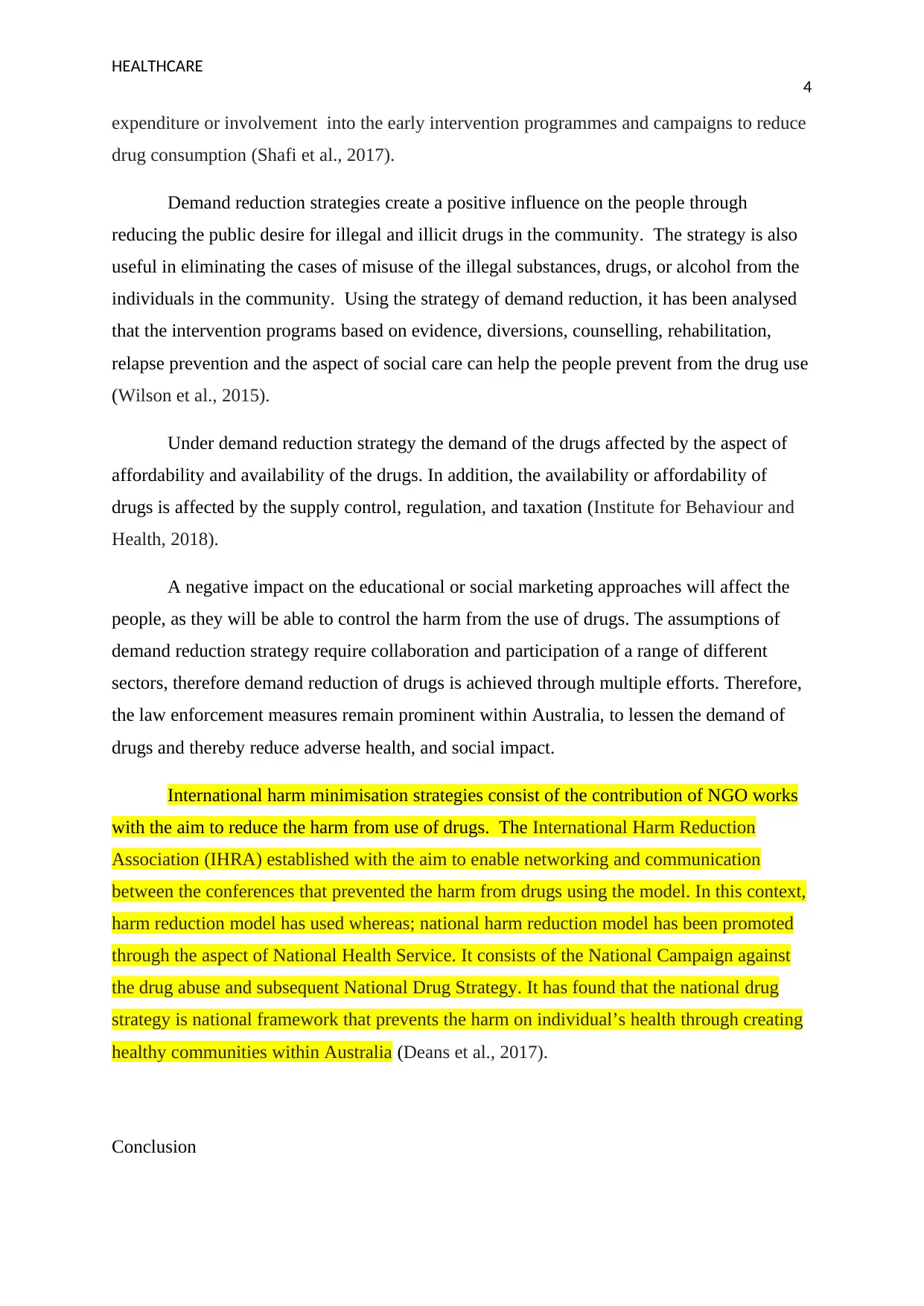
HEALTHCARE
4
expenditure or involvement into the early intervention programmes and campaigns to reduce
drug consumption (Shafi et al., 2017).
Demand reduction strategies create a positive influence on the people through
reducing the public desire for illegal and illicit drugs in the community. The strategy is also
useful in eliminating the cases of misuse of the illegal substances, drugs, or alcohol from the
individuals in the community. Using the strategy of demand reduction, it has been analysed
that the intervention programs based on evidence, diversions, counselling, rehabilitation,
relapse prevention and the aspect of social care can help the people prevent from the drug use
(Wilson et al., 2015).
Under demand reduction strategy the demand of the drugs affected by the aspect of
affordability and availability of the drugs. In addition, the availability or affordability of
drugs is affected by the supply control, regulation, and taxation (Institute for Behaviour and
Health, 2018).
A negative impact on the educational or social marketing approaches will affect the
people, as they will be able to control the harm from the use of drugs. The assumptions of
demand reduction strategy require collaboration and participation of a range of different
sectors, therefore demand reduction of drugs is achieved through multiple efforts. Therefore,
the law enforcement measures remain prominent within Australia, to lessen the demand of
drugs and thereby reduce adverse health, and social impact.
International harm minimisation strategies consist of the contribution of NGO works
with the aim to reduce the harm from use of drugs. The International Harm Reduction
Association (IHRA) established with the aim to enable networking and communication
between the conferences that prevented the harm from drugs using the model. In this context,
harm reduction model has used whereas; national harm reduction model has been promoted
through the aspect of National Health Service. It consists of the National Campaign against
the drug abuse and subsequent National Drug Strategy. It has found that the national drug
strategy is national framework that prevents the harm on individual’s health through creating
healthy communities within Australia (Deans et al., 2017).
Conclusion
4
expenditure or involvement into the early intervention programmes and campaigns to reduce
drug consumption (Shafi et al., 2017).
Demand reduction strategies create a positive influence on the people through
reducing the public desire for illegal and illicit drugs in the community. The strategy is also
useful in eliminating the cases of misuse of the illegal substances, drugs, or alcohol from the
individuals in the community. Using the strategy of demand reduction, it has been analysed
that the intervention programs based on evidence, diversions, counselling, rehabilitation,
relapse prevention and the aspect of social care can help the people prevent from the drug use
(Wilson et al., 2015).
Under demand reduction strategy the demand of the drugs affected by the aspect of
affordability and availability of the drugs. In addition, the availability or affordability of
drugs is affected by the supply control, regulation, and taxation (Institute for Behaviour and
Health, 2018).
A negative impact on the educational or social marketing approaches will affect the
people, as they will be able to control the harm from the use of drugs. The assumptions of
demand reduction strategy require collaboration and participation of a range of different
sectors, therefore demand reduction of drugs is achieved through multiple efforts. Therefore,
the law enforcement measures remain prominent within Australia, to lessen the demand of
drugs and thereby reduce adverse health, and social impact.
International harm minimisation strategies consist of the contribution of NGO works
with the aim to reduce the harm from use of drugs. The International Harm Reduction
Association (IHRA) established with the aim to enable networking and communication
between the conferences that prevented the harm from drugs using the model. In this context,
harm reduction model has used whereas; national harm reduction model has been promoted
through the aspect of National Health Service. It consists of the National Campaign against
the drug abuse and subsequent National Drug Strategy. It has found that the national drug
strategy is national framework that prevents the harm on individual’s health through creating
healthy communities within Australia (Deans et al., 2017).
Conclusion
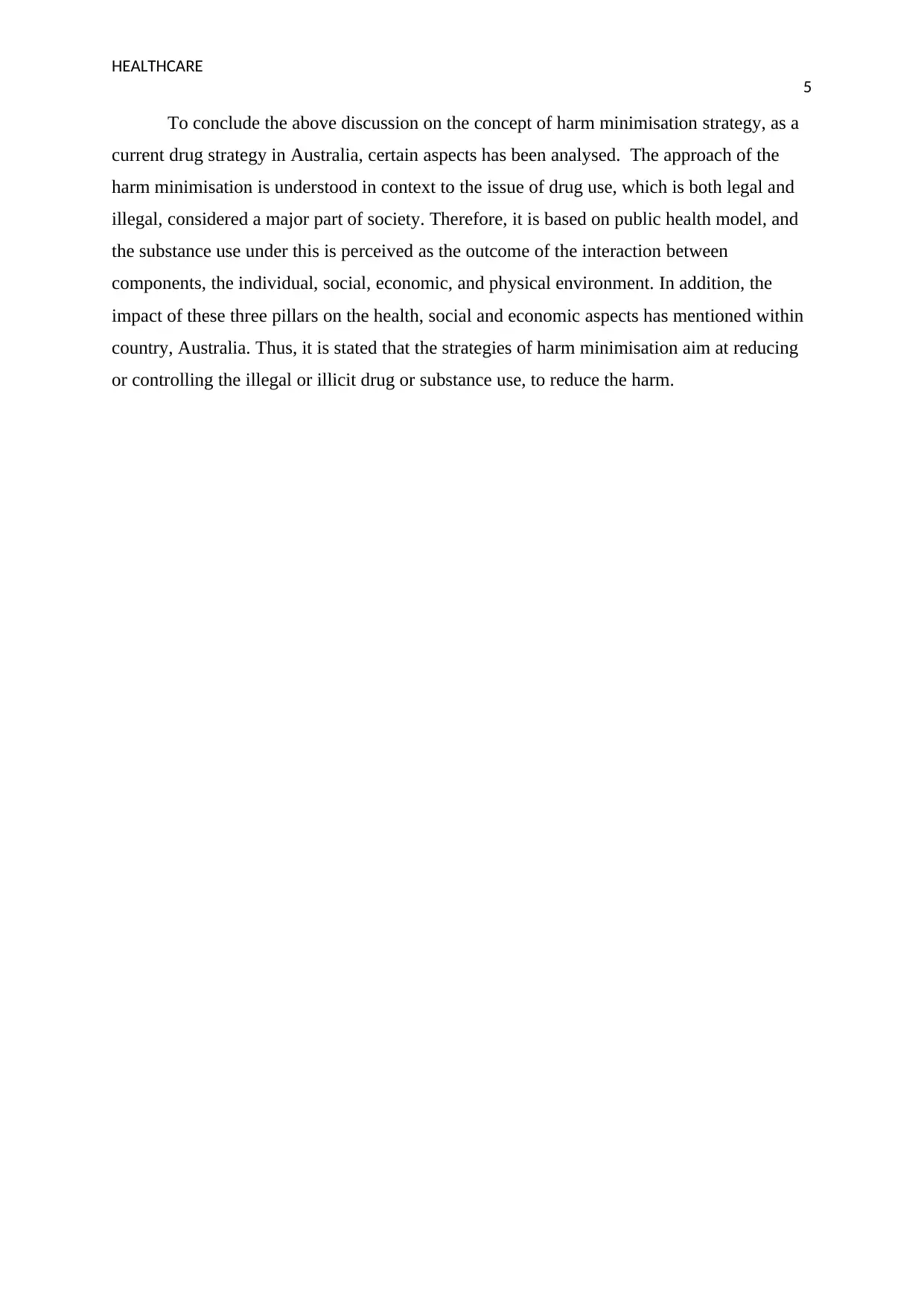
HEALTHCARE
5
To conclude the above discussion on the concept of harm minimisation strategy, as a
current drug strategy in Australia, certain aspects has been analysed. The approach of the
harm minimisation is understood in context to the issue of drug use, which is both legal and
illegal, considered a major part of society. Therefore, it is based on public health model, and
the substance use under this is perceived as the outcome of the interaction between
components, the individual, social, economic, and physical environment. In addition, the
impact of these three pillars on the health, social and economic aspects has mentioned within
country, Australia. Thus, it is stated that the strategies of harm minimisation aim at reducing
or controlling the illegal or illicit drug or substance use, to reduce the harm.
5
To conclude the above discussion on the concept of harm minimisation strategy, as a
current drug strategy in Australia, certain aspects has been analysed. The approach of the
harm minimisation is understood in context to the issue of drug use, which is both legal and
illegal, considered a major part of society. Therefore, it is based on public health model, and
the substance use under this is perceived as the outcome of the interaction between
components, the individual, social, economic, and physical environment. In addition, the
impact of these three pillars on the health, social and economic aspects has mentioned within
country, Australia. Thus, it is stated that the strategies of harm minimisation aim at reducing
or controlling the illegal or illicit drug or substance use, to reduce the harm.
⊘ This is a preview!⊘
Do you want full access?
Subscribe today to unlock all pages.

Trusted by 1+ million students worldwide
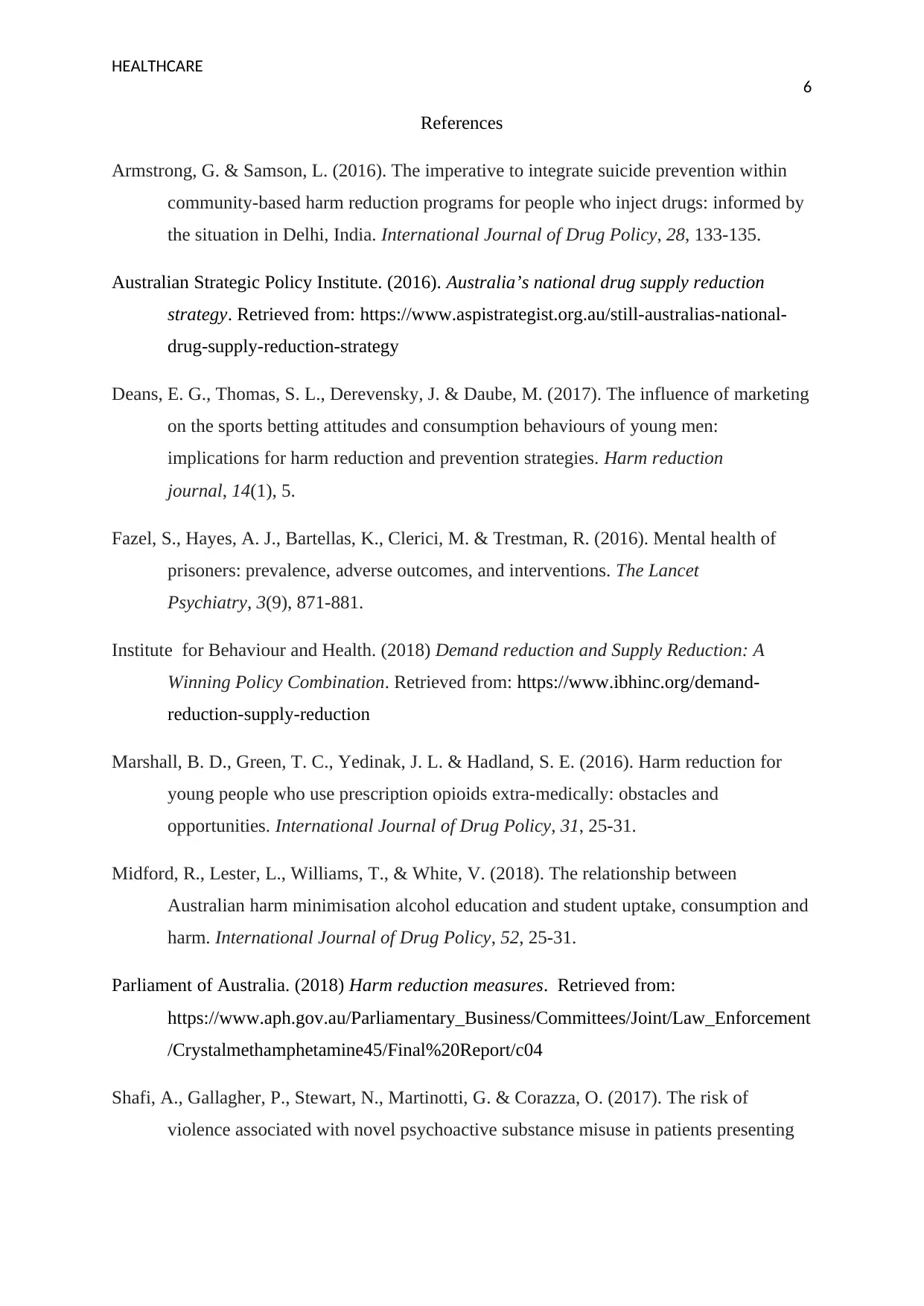
HEALTHCARE
6
References
Armstrong, G. & Samson, L. (2016). The imperative to integrate suicide prevention within
community-based harm reduction programs for people who inject drugs: informed by
the situation in Delhi, India. International Journal of Drug Policy, 28, 133-135.
Australian Strategic Policy Institute. (2016). Australia’s national drug supply reduction
strategy. Retrieved from: https://www.aspistrategist.org.au/still-australias-national-
drug-supply-reduction-strategy
Deans, E. G., Thomas, S. L., Derevensky, J. & Daube, M. (2017). The influence of marketing
on the sports betting attitudes and consumption behaviours of young men:
implications for harm reduction and prevention strategies. Harm reduction
journal, 14(1), 5.
Fazel, S., Hayes, A. J., Bartellas, K., Clerici, M. & Trestman, R. (2016). Mental health of
prisoners: prevalence, adverse outcomes, and interventions. The Lancet
Psychiatry, 3(9), 871-881.
Institute for Behaviour and Health. (2018) Demand reduction and Supply Reduction: A
Winning Policy Combination. Retrieved from: https://www.ibhinc.org/demand-
reduction-supply-reduction
Marshall, B. D., Green, T. C., Yedinak, J. L. & Hadland, S. E. (2016). Harm reduction for
young people who use prescription opioids extra-medically: obstacles and
opportunities. International Journal of Drug Policy, 31, 25-31.
Midford, R., Lester, L., Williams, T., & White, V. (2018). The relationship between
Australian harm minimisation alcohol education and student uptake, consumption and
harm. International Journal of Drug Policy, 52, 25-31.
Parliament of Australia. (2018) Harm reduction measures. Retrieved from:
https://www.aph.gov.au/Parliamentary_Business/Committees/Joint/Law_Enforcement
/Crystalmethamphetamine45/Final%20Report/c04
Shafi, A., Gallagher, P., Stewart, N., Martinotti, G. & Corazza, O. (2017). The risk of
violence associated with novel psychoactive substance misuse in patients presenting
6
References
Armstrong, G. & Samson, L. (2016). The imperative to integrate suicide prevention within
community-based harm reduction programs for people who inject drugs: informed by
the situation in Delhi, India. International Journal of Drug Policy, 28, 133-135.
Australian Strategic Policy Institute. (2016). Australia’s national drug supply reduction
strategy. Retrieved from: https://www.aspistrategist.org.au/still-australias-national-
drug-supply-reduction-strategy
Deans, E. G., Thomas, S. L., Derevensky, J. & Daube, M. (2017). The influence of marketing
on the sports betting attitudes and consumption behaviours of young men:
implications for harm reduction and prevention strategies. Harm reduction
journal, 14(1), 5.
Fazel, S., Hayes, A. J., Bartellas, K., Clerici, M. & Trestman, R. (2016). Mental health of
prisoners: prevalence, adverse outcomes, and interventions. The Lancet
Psychiatry, 3(9), 871-881.
Institute for Behaviour and Health. (2018) Demand reduction and Supply Reduction: A
Winning Policy Combination. Retrieved from: https://www.ibhinc.org/demand-
reduction-supply-reduction
Marshall, B. D., Green, T. C., Yedinak, J. L. & Hadland, S. E. (2016). Harm reduction for
young people who use prescription opioids extra-medically: obstacles and
opportunities. International Journal of Drug Policy, 31, 25-31.
Midford, R., Lester, L., Williams, T., & White, V. (2018). The relationship between
Australian harm minimisation alcohol education and student uptake, consumption and
harm. International Journal of Drug Policy, 52, 25-31.
Parliament of Australia. (2018) Harm reduction measures. Retrieved from:
https://www.aph.gov.au/Parliamentary_Business/Committees/Joint/Law_Enforcement
/Crystalmethamphetamine45/Final%20Report/c04
Shafi, A., Gallagher, P., Stewart, N., Martinotti, G. & Corazza, O. (2017). The risk of
violence associated with novel psychoactive substance misuse in patients presenting
Paraphrase This Document
Need a fresh take? Get an instant paraphrase of this document with our AI Paraphraser
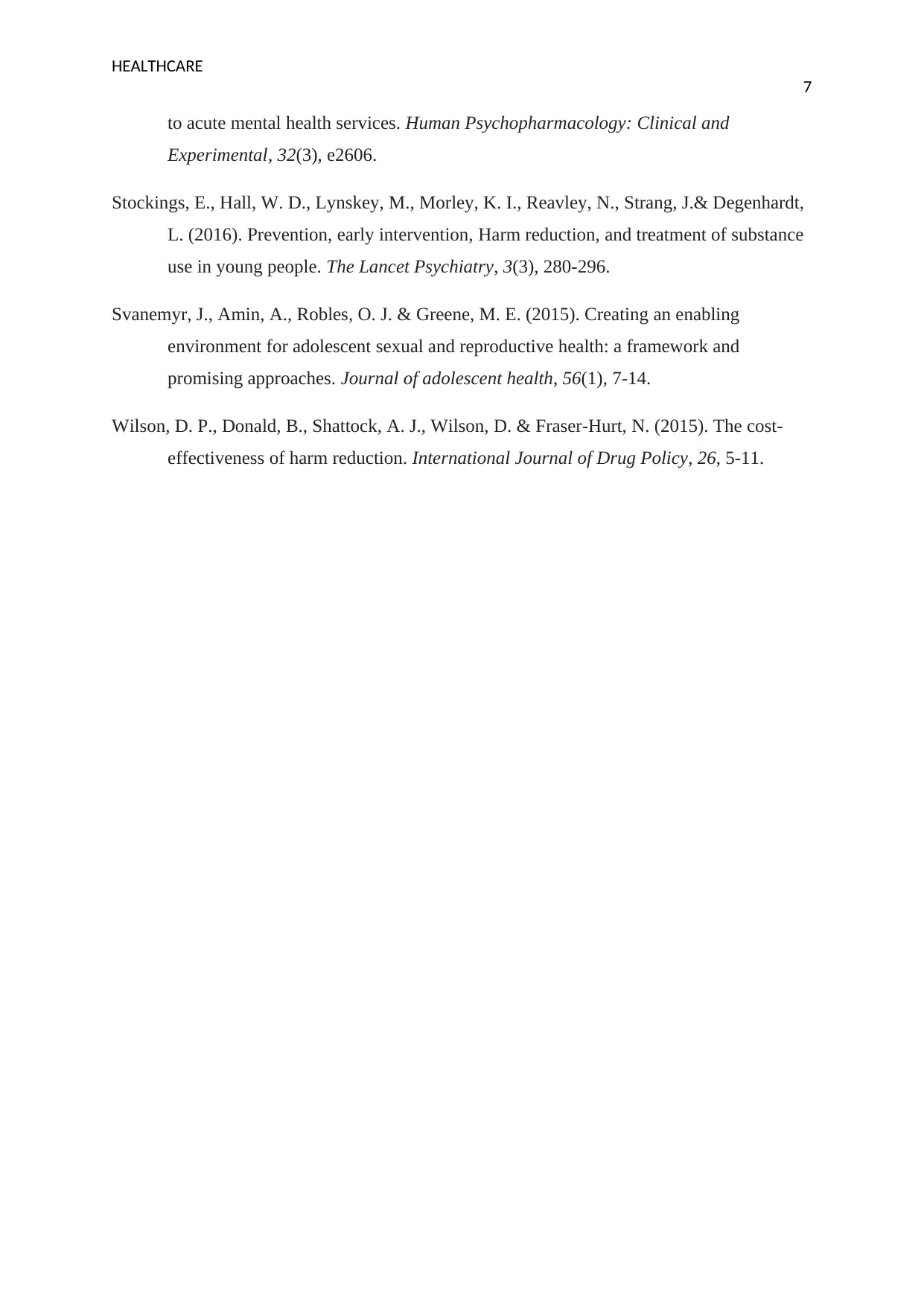
HEALTHCARE
7
to acute mental health services. Human Psychopharmacology: Clinical and
Experimental, 32(3), e2606.
Stockings, E., Hall, W. D., Lynskey, M., Morley, K. I., Reavley, N., Strang, J.& Degenhardt,
L. (2016). Prevention, early intervention, Harm reduction, and treatment of substance
use in young people. The Lancet Psychiatry, 3(3), 280-296.
Svanemyr, J., Amin, A., Robles, O. J. & Greene, M. E. (2015). Creating an enabling
environment for adolescent sexual and reproductive health: a framework and
promising approaches. Journal of adolescent health, 56(1), 7-14.
Wilson, D. P., Donald, B., Shattock, A. J., Wilson, D. & Fraser-Hurt, N. (2015). The cost-
effectiveness of harm reduction. International Journal of Drug Policy, 26, 5-11.
7
to acute mental health services. Human Psychopharmacology: Clinical and
Experimental, 32(3), e2606.
Stockings, E., Hall, W. D., Lynskey, M., Morley, K. I., Reavley, N., Strang, J.& Degenhardt,
L. (2016). Prevention, early intervention, Harm reduction, and treatment of substance
use in young people. The Lancet Psychiatry, 3(3), 280-296.
Svanemyr, J., Amin, A., Robles, O. J. & Greene, M. E. (2015). Creating an enabling
environment for adolescent sexual and reproductive health: a framework and
promising approaches. Journal of adolescent health, 56(1), 7-14.
Wilson, D. P., Donald, B., Shattock, A. J., Wilson, D. & Fraser-Hurt, N. (2015). The cost-
effectiveness of harm reduction. International Journal of Drug Policy, 26, 5-11.
1 out of 8
Related Documents
Your All-in-One AI-Powered Toolkit for Academic Success.
+13062052269
info@desklib.com
Available 24*7 on WhatsApp / Email
![[object Object]](/_next/static/media/star-bottom.7253800d.svg)
Unlock your academic potential
Copyright © 2020–2025 A2Z Services. All Rights Reserved. Developed and managed by ZUCOL.





